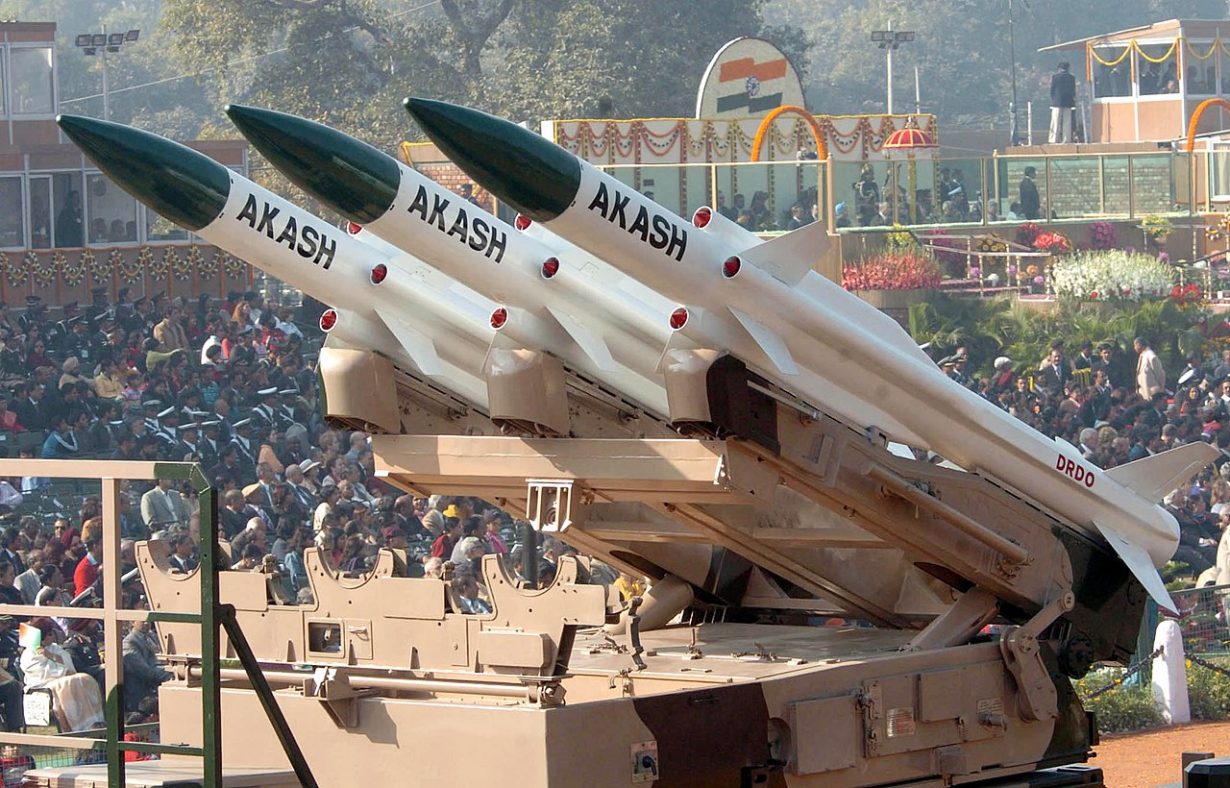Indian “Iron-Dome” Akash Surface-to-Air Missile (SAM) is competing against Chinese-made Sky Dragon-50 air defense systems to secure an order from Brazil. Reports indicate that Brazilian forces have started evaluating the systems, even as the South American top brass is pushing for a government-to-government deal for the Akash missiles.
The system’s evaluation follows the Brazilian Army’s publication of the Ordinance on June 21 for the acquisition of the Medium Altitude/High Altitude Air Defense Artillery System Project. The project is part of the Army’s strategic program for air defense.
The Brazilian forces set the ball rolling in November 2023, when the Brazilian Army issued a Request for Quote (RFQ) for the prices of the medium-altitude air defense systems available nationally and internationally. A second RFQ was issued in February 2024 for additional information.
Brazilian military chief General Tomas Miguel Mine Ribeiro Paiva suggested a “government-to-government” agreement with India to acquire the Akash anti-aircraft missile system. He is scheduled to visit China in August to discuss potential bilateral cooperation.
A Brazilian Army delegation previously visited China in 2023 for a live fire demonstration of the Sky Dragon 50 or Tianlong-50 and the SH15 self-propelled howitzer, both produced by China North Industries Corporation.
General Paiva witnessed a live demonstration of India’s Akash Air Defense Missile System in August 2023. He was also shown other Indian-made defense platforms, such as the advanced Arjun tanks and versatile Advanced Light Helicopter (ALH) Dhruva helicopters.
The event highlighted the Akash system’s prowess in safeguarding airspace and showcased India’s self-reliance in defense technology.
While Sky Dragon 50 has been categorized as medium-range SAM, its range is not in the public domain. On the other hand, Akash is a short-range SAM system manufactured by Bharat Dynamics Limited (BDL) to protect vulnerable areas and points from air attacks.
According to the BDL website, the Akash Weapon System (AWS) can simultaneously engage Multiple Targets in Group Mode or Autonomous Mode. It has built-in Electronic Countermeasures (ECCM) features. The entire weapon system is mounted on mobile platforms.
It can effectively engage helicopters, fighter jets, and UAVs flying in the range of 4-25 kilometers. It is fully automatic and has a quick response time from target detection to kill.
The Indian Defense Research and Development Organisation (DRDO) claims that it is the first system in the world capable of engaging four aerial targets simultaneously at 25 kilometers of range by command guidance using a single firing unit.
It is highly immune to active and passive jamming. It can be transported swiftly via rail or road and deployed quickly. The project’s overall indigenous content is 82 percent, which will increase to 93 percent by 2026-27.
Armenia has already placed an order to acquire the Indian-built SAM. Multiple countries from South America, the Middle East, and Africa have shown interest in the acquisition of the indigenous Akash Missile system.
The Philippines and Vietnam have also shown interest in the weapon system.
Akash – Sky Is The limit
The Akash weapon system’s mobility, mounted on trucks, makes it agile and nimble in the battleground and enhances its survivability. The Indian Army and the Air Force have already inducted the Akash.

Akash has already evoked a comparison with the Israeli Iron Dome. But the Akash system is bigger than the Iron Dome missiles, and it can also intercept unmanned aerial vehicles and other types of smaller incoming projectiles, in addition to helicopters and aircraft.
The weapon system can be made fully automatic with a quick response time from target detection to kill. Its open-system architecture ensures adaptability to existing and futuristic air defense environments.
In December 2023, the firepower of the Akash Missile system was demonstrated during the IAF’s Astrashakti exercise. During the exercise, a single Akash missile system engaged four unmanned aerial targets simultaneously. The four targets came from the same direction in a close formation and split to attack defense assets from multiple directions simultaneously.
Chinese Stealth Jet ‘Outguns’ Indian AMCA; Puts Pakistan A Generation Ahead Of IAF – Chinese Expert
The Akash missile comes in two upgraded varieties: Akash-NG (New Generation) and Akash Prime. They both have a flying height of around 18 km and an operational range of 27–30 km. Nonetheless, Akash Prime possesses an extra native active Radio Frequency (RF) seeker, which enhances its accuracy when striking airborne targets. Additional enhancements to the system comprise enhanced dependability in low-temperature conditions at elevated elevations.
According to former DRDO scientist Ravi Kumar Gupta, Akash’s versatility is an advantage over other systems. He told the Eurasian Times that, unlike other surface-to-air missiles that work only in particular altitudes and climates, Akash’s biggest advantage is that it can work at “all places.”
“The systems are developed for diverse conditions that can withstand extreme conditions anywhere in the world, which makes them ‘most reliable and sturdy.’ Since the system is fully indigenous, India can fine-tune it to any of the buyer’s requirements in a cost-effective manner with a high degree of effectiveness against the adversary,” Gupta said.
- Ritu Sharma has been a journalist for over a decade, writing on defense, foreign affairs, and nuclear technology.
- The author can be reached at ritu.sharma (at) mail.com
- Follow EurAsian Times on Google News